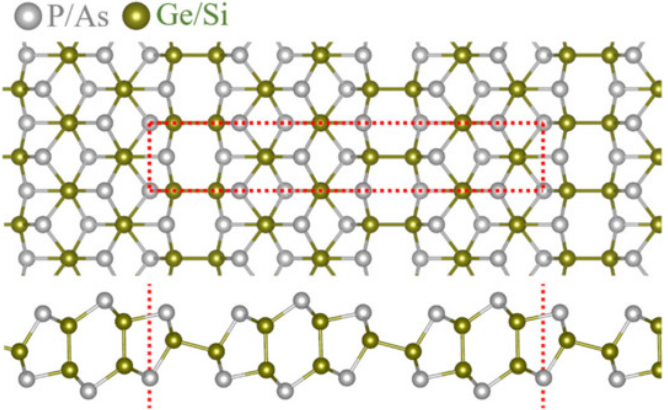Group IV-V type layered materials, such as SiP, SiAs, GeP and GeAs, are among the most attractive two-dimensional (2D) materials that exhibit anisotropic mechanical, optical and transport properties. In this short communication, we conducted density functional theory simulations to explore the prospect of SiP, SiAs, GeP and GeAs nanosheets for the water-splitting application. The semiconducting gaps of stress-free SiP, SiAs, GeP and GeAs monolayers were estimated to be 2.59, 2.34, 2.30 and 2.07 eV, respectively, which are within the desirable ranges for the water splitting. Moreover, all the considered nanomaterials were found to yield optical absorption in the visible spectrum, which is a critical feature for the employment in the solar water splitting systems. Our results furthermore confirm that the valence and conduction band edge positions in SiP, SiAs, GeP and GeAs monolayers also satisfy the requirements for the water splitting. Our results highlight the promising photocatalytic characteristics of SiP, SiAs, GeP and GeAs nanosheets for the application in solar water splitting and design of advanced hydrogen fuel cells.

Group IV-V type layered materials, such as SiP, SiAs, GeP and GeAs, are among the most attractive two-dimensional (2D) materials that exhibit anisotropic mechanical, optical and transport properties. In this short communication, we conducted density functional theory simulations to explore the prospect of SiP, SiAs, GeP and GeAs nanosheets for the water-splitting application. The semiconducting gaps of stress-free SiP, SiAs, GeP and GeAs monolayers were estimated to be 2.59, 2.34, 2.30 and 2.07 eV, respectively, which are within the desirable ranges for the water splitting. Moreover, all the considered nanomaterials were found to yield optical absorption in the visible spectrum, which is a critical feature for the employment in the solar water splitting systems. Our results furthermore confirm that the valence and conduction band edge positions in SiP, SiAs, GeP and GeAs monolayers also satisfy the requirements for the water splitting. Our results highlight the promising photocatalytic characteristics of SiP, SiAs, GeP and GeAs nanosheets for the application in solar water splitting and design of advanced hydrogen fuel cells.
